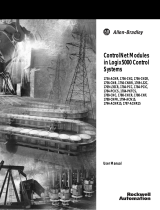Page is loading ...

Publication 1747-IN017C-EN-P - May 2001
Installation Instructions
ControlNet Adapter Module
1747-ACN15, 1747-ACNR15
What This Document Describes
For information on: Refer to page:
Additional Documentation 2
Module Description and Features 4
Hardware Components 4
Determining Power Requirements 6
Installing the Adapter Module 7
Connecting Programming Terminals 12
Powerup Sequence 13
Troubleshooting 14
ControlNet Status Indicators 16
Specifications 19
Allen-Bradley Automation

2 ControlNet Adapter Module
Publication 1747-IN017C-EN-P - May 2001
User Manual and Other Related Documentation
For detailed information on how to use the ControlNet Adapter Module, refer to the
ControlNet Adapter Module User Manual, publication 1747-UM003A-EN-P.
For detailed information on planning and installing your ControlNet system, refer to
the following publications:
If you would like any of this documentation, you can:
• download a free electronic version from the internet:
www.theautomationbookstore.com
• purchase a printed copy by:
– contacting your local distributor or Rockwell Automation representative
– visiting www.theautomationbookstore.com and placing your order
Publication Publication Number
ControlNet Adapter User Manual 1747-UM003A-EN-P
ControlNet Cable System Component List AG-2.2
ControlNet Cable System Planning and Installation Manual 1786-6.2.1
ControlNet Coax Tap Installation Instructions 1786-IN007A-EN-P
ControlNet Network Access Cable Installation Instructions 1786-2.6
ControlNet Repeater Installation Instructions 1786-5.13
Industrial Automation Wiring and Grounding Guidelines 1770-4.1

ControlNet Adapter Module 3
Publication 1747-IN017C-EN-P - May 2001
European Communities (EC) Directive Compliance
If this product has the CE mark it is approved for installation within the European
Union and EEA regions. It has been designed and tested to meet the following
directives.
EMC Directive
This product is tested to meet the Council Directive 89/336/EC Electromagnetic
Compatibility (EMC) by applying the following standards, in whole or in part,
documented in a technical construction file:
• EN 50081-2 EMC — Generic Emission Standard, Part 2 — Industrial
Environment
• EN 50082-2 EMC — Generic Immunity Standard, Part 2 — Industrial
Environment
This product is intended for use in an industrial environment.
Low Voltage Directive
This product is tested to meet Council Directive 73/23/EEC Low Voltage, by
applying the safety requirements of EN 61131-2 Programmable Controllers, Part 2 -
Equipment Requirements and Tests. For specific information required by EN
61131-2, see the appropriate sections in this publication, as well as the
Allen-Bradley publication Industrial Automation Wiring and Grounding Guidelines,
publication 1770-4.1.
Open style devices must be provided with environmental and safety protection by
proper mounting in enclosures designed for specific application conditions. See
NEMA Standards publication 250 and IEC publication 529, as applicable, for
explanations of the degrees of protection provided by different types of enclosure.
Allen-Bradley Automation

4 ControlNet Adapter Module
Publication 1747-IN017C-EN-P - May 2001
Module Description and Features
The 1747-ACN15 and -ACNR15 adapters control 1746 remote I/O on the ControlNet
network. The ControlNet network is a communication architecture that allows the
exchange of messages between ControlNet products compliant with the CI
specification.
The adapters support multiple scheduled connections to individual modules or rack
scheduled connections to a group of modules. Up to 64 scheduled connections per
adapter are possible with a maximum of 251 input words and/or 249 output words
supported per scheduled connection. An adapter can control up to 30 slots of 1746
I/O (3 chassis max.).
The 1747-ACN15 and -ACNR15 adapters features include:
• high-speed data transfer
• diagnostic messages
• local communication network access through the network access port (NAP)
• redundant media (1747-ACNR15 only)
• unscheduled messaging
• multicast outputs
• PLC-5 ControlNet hot backup
Hardware Components
The adapter module consists of the following major components, as shown in the
following figure:
• ControlNet status and health indicators
• status display and network address
• network access port (NAP)
• ControlNet connectors (one on 1747-ACN15; two on 1747-ACNR15)
• module net address switch assemblies (on top of module)

ControlNet Adapter Module 5
Publication 1747-IN017C-EN-P - May 2001
Diagnostic Indicators
Health indicators are located on the front panel of the adapter module. They
indicate both normal operation and error conditions in your remote I/O system.
An alphanumeric display (net address/status) provides status code indications when
an error occurs during initialization or operation.
A complete description of the diagnostic indicators and status display and how to
use them for troubleshooting is explained on page 14.
Network Access Port (NAP)
The network access port provides a bidirectional electrical interface for
programming, maintenance, and I/O monitoring devices in both redundant and
non-redundant connections. How to connect programming terminals to the
network using the NAP is described on page 12.
ADDRESS/STATUS
ADDRESS/STATUS
B
A
A
A
A
B
OK OK
Module Network Address Switches
(accessible through top of module)
Health Indicators
ControlNet Status Indicators
Diagnostic Indicators
Network Access Port (NAP)
1747-ACNR15
ControlNet Media Port (A)
ControlNet Redundant Media Port (B) (1747-ACNR15 only)
1747-ACN15
Status Display and Net
Address
Allen-Bradley Automation

6 ControlNet Adapter Module
Publication 1747-IN017C-EN-P - May 2001
ControlNet Connectors
Cable connection to the module is through standard BNC connectors on the front
of the module, as shown below.
.
1. End device supporting redundant cabling is a 1747-ACNR15.
Refer to the ControlNet Cable System Planning and Installation User Manual,
Publication 1786-6.2.1 for more information.
Network Address Switch Assemblies
You must set two switch assemblies to configure your adapter module with its
unique network address. You access these switches through the top of the module.
The following figure shows the location of the switches. These switches are read on
power-up to establish the network address of the module. Network address switch
settings are described on page 7.
Determining Power Requirements
The ControlNet adapter module requires a maximum backplane current of 900mA
at 5VDC. Remember to add this amount to other current requirements for your I/O
chassis.
B
A
Example of a Redundant System
trunkline A =
trunkline B =
Terminator
Terminator
SLC 5/02 or later
with 1747-SCNR
end device
1

ControlNet Adapter Module 7
Publication 1747-IN017C-EN-P - May 2001
Setting the Network Address Switches
The switches on the top of the adapter module determine the network address of
the adapter. The two switches are:
• the ten’s switch
• the one’s switch
The combination of these switches allows selection of network addresses from 01
to 99.
Installing the Adapter Module in the Chassis
After you set the appropriate switch assemblies for your adapter module, follow
these procedures for installation.
Refer to the Industrial Controller Wiring and Grounding Guidelines publication
1770-4.1 for proper grounding and wiring methods to use when installing your
module.
TIP
00 is an invalid number.
Ten’s Selection
One’s
Selection
Allen-Bradley Automation

8 ControlNet Adapter Module
Publication 1747-IN017C-EN-P - May 2001
1. Remove power from the I/O chassis before inserting (or removing) the
module.
2. Align the circuit board with the chassis card guide in the left slot.
3. Slide the module into the chassis until the top and bottom latches are
latched.
4. Press firmly and evenly to seat the module in its backplane connectors. To
remove the module, press the releases at the top and bottom of the module
and pull it out.
WARNING
!
If you insert or remove the ControlNet Adapter with power
applied to this module or any device on the network, an
electrical arc can occur. This could cause an explosion in
hazardous location installations. Be sure that power is
removed or the area is nonhazardous before proceeding.
ATTENTION
!
Do not force the module into the backplane connector. If you
cannot seat the module with firm pressure, check the
alignment. Forcing the module can damage the backplane
connector or the module.
Latch
Card Guide
Power
Supply

ControlNet Adapter Module 9
Publication 1747-IN017C-EN-P - May 2001
Connecting Your Adapter to the ControlNet Network
Connect your 1747-ACN15 or -ACNR15 adapter module to a ControlNet network via
taps. as shown below:
1. Remove the tap’s dust cap (located on the straight or right angle connector).
IMPORTANT
Taps contain passive electronics and must be purchased from
Rockwell Automation for the network to function properly.
If your node supports: Connect the tap’s straight or right angle connector:
Non-redundant media to the channel A connector on the 1747-ACN15 or 1747-ACNR15
(channel B on the 1747-ACNR15 is not used)
(1)
(1)
While both channels are active, we recommend using channel A for non-redundant media.
Redundant media • from trunkline A to channel A on the 1747-ACNR15
• from trunkline B to channel B on the 1747-ACNR15
ATTENTION
!
Do not allow any metal portions of the tap to contact any
conductive material. If you disconnect the tap from the
adapter, place the dust cap back on the straight or right angle
connector to prevent the connector from accidentally
contacting a metallic grounded surface.
Straight T-tap
Straight Y-tap
Right-angle T-tap Right-angle Y-tap
1766-TPS 1786-TPYS
1786-TPR
1786-TPYR
segment 1
Tap
dust cap
Allen-Bradley Automation

10 ControlNet Adapter Module
Publication 1747-IN017C-EN-P - May 2001
2. Remove and discard the dust caps from the adapter BNC jacks.
3. Remove and discard the dust caps from the adapter BNC jacks.
4. Connect this tap’s straight or right angle connector to the BNC connector on
the adapter.
ATTENTION
!
Do not allow any metal portions of the tap to contact any
conductive material. If you disconnect the tap from the
adapter, place the dust cap back on the straight or right angle
connector to prevent the connector from accidentally
contacting a metallic grounded surface.
segment 1
Tap
dust cap
segment 1
Tap
dust cap
segment 1
tap
IMPORTANT
To prevent inadvertent
reversal of the top
connections (resulting in
incorrect LED displays and
troubleshooting), check the
tap drop cable for a label
indicating the attached
segment before making your
connection.

ControlNet Adapter Module 11
Publication 1747-IN017C-EN-P - May 2001
5. For redundant adapters (1747-ACNR15), remove (and save) the dust cap
located on the straight or right angle connector of the designated tap on the
second segment (segment 2).
6. Connect this tap’s straight or right angle connector to the BNC connector on
the adapter.
7. After terminating your segments, connect the node to the network.
segment 2
tap
dust cap
segment 1
tap
segment 2
tap
Allen-Bradley Automation

12 ControlNet Adapter Module
Publication 1747-IN017C-EN-P - May 2001
Connecting Programming Terminals to the Network via the NAP
You can connect programming terminals to the ControlNet network by connecting
to the network access port (NAP). Two methods are shown below.
ATTENTION
!
Use the 1786-CP cable when connecting a programming
terminal to the network through NAPs. Using a commercially
available RJ-style cable could result in possible network
failures.
Using 1784-KTC or -KTCx communication card
and NAP
Programming
Terminal
1784-KTC or
-KTCx
1786-CP
1
ControlNet
product
ControlNet network
Using 1770-KFC communication
interface and NAP
Programming
Terminal
Serial or Parallel
Connection
ControlNet Network
1. The 1786-CP cable can be plugged into any ControlNet product’s NAP to provide programming capability on the
ControlNet network. A programming terminal connected through this cable is counted as a node and must have a
unique address.
1786-CP
1
1770-KFC
ControlNet
product

ControlNet Adapter Module 13
Publication 1747-IN017C-EN-P - May 2001
Powerup Sequence
There are three health indicators on the module. The indicator on the right (labeled
“OK”) is the general module health indicator. The indicator in the middle (labeled
“A”) is the health indicator for cable A. On the 1747-ACNR15, the indicator on the
left (labeled “B”) is the health indicator for cable B. Also, the alphanumeric display
can display module status. The following describes the normal power-up sequence
for the adapter module.
1. Apply power to the chassis - notice that the A and B indicators are off, the
OK indicator is red, and the status window indicates “POST” (Power On Self
Test).
2. After “POST”, the status window displays the sequence “0000”, “1111”,
“2222”, through “9999”. During this time, the A and B indicators are off and
the OK indicator appears amber.
3. The series and revision levels are then displayed in the status window. A
series A revision level B module would display “A/B”. During this time, the
A and B indicators are off and the OK indicator appears amber.
4. After the operating system is loaded and initialized, the status window and
the indicators indicate the status of the module and its connections to the
cable(s). If the module address is not zero and a valid ControlNet connection
is made to either channel A or B, then the status window toggles between
“ACTV” (Active) and the module node address (“A#02” equals node address
number 2). If there are no active connections, the status window displays
“IDLE”.
5. If there is a hardware problem of any kind, the health indicator turns red
and the status window toggles between “FATL” and either one or two
numbers. The “FATL” indicates that there was a fatal error, and the numbers
indicate the error code.
ADDRESS/STATUS
B
A
OK
Status
Health Indicators
Channel A and B
indicators
Allen-Bradley Automation

14 ControlNet Adapter Module
Publication 1747-IN017C-EN-P - May 2001
Troubleshooting With the Status Indicators and Status Display
The module has indicators on the front panel as shown below. These indicators
consist of:
• health indicators
• status indicators
• display of status and address
Use these indicators to troubleshoot the module.
The following tables describe how to use the indicators to troubleshoot your
module.
Health Indicators and Display Mnemonics
OK LED Display Description Probable Cause Recommended Action
Off None Module is not
communicating.
Power supply fault. Check power supply, and
seat adapter firmly in
chassis.
Off None Module is not
communicating.
Defective adapter. Replace adapter.
Off POST Adapter is running
Power On Self Test.
None None
Amber 0000 through
9999
Adapter is running
Power On Self Test.
None None
Amber A/A Adapter is
displaying Series
and Revision level.
None None
ADDRESS/STATUS
ADDRESS/STATUS
B
A
A
A
A
B
OK OK
Status Display and Net
Address
Health Indicators ControlNet
Status Indicators
1747-ACN15
1747-ACNR15

ControlNet Adapter Module 15
Publication 1747-IN017C-EN-P - May 2001
Solid Red FATL Number
Number
Module is not
communicating.
The adapter has either failed
a hardware test, or gone into
a state from which it cannot
recover. The two numbers
following the FATL describe
the problem in detail.
Document the two numbers.
Power cycle the adapter.
Contact Technical Support at
440.646.6800.
Flashing Red A#00 ERR Module is not
communicating.
The node address switches
are set to 00 which is not
valid.
Power the adapter off,
remove the adapter from the
chassis, change the node
address switch to something
other than 00, replace the
adapter in the chassis, and
apply power.
Flashing Red DUP NODE Module is not
communicating.
The adapter has detected a
duplicated node address on
the network.
Correct the duplicate node
address problem.
Flashing Red CPU OVER Module is not
communicating.
The ControlNet configuration
has overloaded the central
processing unit in the
adapter.
Reduce load on adapter by
removing some connections
or increasing the connection
RPI values.
Flashing
Green
IDLE Module is working
properly, but there
are no active
connections.
None None
Flashing
Green
NET ERR Module is not
communicating.
The adapter has detected a
cable fault and is attempting
to recover. The adapter is
sending the three “I’m
alive!” packets.
None, check cable if problem
persists.
Solid Green ACTV A#XX Module is working
properly.
None None
Solid Green BOOT A#XX Module is on
network, but not
supporting any
connections.
The main code in the module
has failed, or the main code
is being updated.
Update the main code with
the latest Series and
Revision code.
Off CODE UPDT
A#XX
Firmware update
mode.
Adapter firmware is being
updated via ControlFlash
update utility.
None
OK LED Display Description Probable Cause Recommended Action
Allen-Bradley Automation

16 ControlNet Adapter Module
Publication 1747-IN017C-EN-P - May 2001
ControlNet Status Indicators
• steady - indicator is on continuously in the defined state.
• alternating - the two indicators alternate between the two defined states at
the same time (applies to both indicators viewed together). The two
indicators are always in opposite states, out of phase.
• flashing - the indicator alternates between the two defined states (applies to
each indicator viewed independent of the other). If both indicators are
flashing, they must flash together, in phase.
Cause Action
Off No power None or power up
Steady red Faulted unit Cycle power
If fault persists, contact Technical Support at
440.646.6800.
Alternating
red/green
Self-test None
Alternating red/off Incorrect node configuration Check network address and other ControlNet
configuration parameters
Cause Action
Off Channel disabled Program network for redundant media, if required
Steady green Normal operation None
Flashing green/off Temporary errors None; unit will self-correct
Listen only Cycle power
Flashing red/off Media fault Check media for broken cables, loose connectors,
missing terminators, etc.
No other nodes present on
network
Add other nodes to the network
Flashing red/green Incorrect network
configuration
Cycle power or reset unit
If fault persists, contact Technical Support at
440.646-6800.
B
A
and
B
A
or

ControlNet Adapter Module 17
Publication 1747-IN017C-EN-P - May 2001
The following information applies when operating this equipment in
hazardous locations:
Products marked “CL I, DIV 2, GP A, B, C, D” are suitable for use in Class I Division
2 Groups A, B, C, D, Hazardous Locations and nonhazardous locations only. Each
product is supplied with markings on the rating nameplate indicating the hazardous
location temperature code. When combining products within a system, the most
adverse temperature code (lowest “T” number) may be used to help determine the
overall temperature code of the system. Combinations of equipment in your system
are subject to investigation by the local Authority Having Jurisdiction at the time of
installation.
WARNING
!
EXPLOSION HAZARD
• Do not disconnect equipment unless power
has been removed or the area is known to be
nonhazardous.
• Do not disconnect connections to this
equipment unless power has been removed
or the area is known to be nonhazardous.
Secure any external connections that mate to
this equipment by using screws, sliding
latches, threaded connectors, or other means
provided with this product.
• Substitution of components may impair
suitability for Class I, Division 2.
• If this product contains batteries, they must
only be changed in an area known to be
nonhazardous.
Allen-Bradley Automation

18 ControlNet Adapter Module
Publication 1747-IN017C-EN-P - May 2001
Informations sur l’utilisation de cet équipement en environnements dangereux :
Les produits marqués « CL I, DIV 2, GP A, B, C, D » ne conviennent qu’à une
utilisation en environnements de Classe I Division 2 Groupes A, B, C, D dangereux
et non dangereux. Chaque produit est livré avec des marquages sur sa plaque
d’identification qui indiquent le code de température pour les environnements
dangereux. Lorsque plusieurs produits sont combinés dans un système, le code de
température le plus défavorable (code de température le plus faible) peut être
utilisé pour déterminer le code de température global du système. Les
combinaisons d’équipements dans le système sont sujettes à inspection par les
autorités locales qualifiées au moment de l’installation.
AVERTISSEMENT
!
RISQUE D’EXPLOSION
• Couper le courant ou s’assurer que
l’environnement est classé non dangereux
avant de débrancher l’équipement.
• Couper le courant ou s’assurer que
l’environnement est classé non dangereux
avant de débrancher les connecteurs. Fixer
tous les connecteurs externes reliés à cet
équipement à l’aide de vis, loquets
coulissants, connecteurs filetés ou autres
moyens fournis avec ce produit.
• La substitution de composants peut rendre cet
équipement inadapté à une utilisation en
environnement de Classe 1, Division 2.
• S’assurer que l’environnement est classé non
dangereux avant de changer les piles.

ControlNet Adapter Module 19
Publication 1747-IN017C-EN-P - May 2001
Specifications
Description Specification
Module Location 1746 I/O chassis, leftmost slot
Interconnect Cable Quad shield RG-6 coaxial cable - Refer to the ControlNet Cable
System manual (pub. no. 1786-6.2.1) for more information
Power Dissipation 5 Watts
Thermal Dissipation 17.06 BTU/hr
Backplane Current 900 mA at 5V
Environmental Conditions
Operational Temperature
Storage Temperature
Relative Humidity
+0° to +60°C (+32° to +140°F)
-40°o to +85°C (-40° to +185°F)
5% to 95% (without condensation)
Product Certifications
(when product or packaging is marked)
This product must be mounted within a suitable system enclosure to prevent personal injury resulting from accessibility to live
parts. The interior of this enclosure must be accessible only by the use of a tool.
This industrial control equipment is intended to operate in a Pollution Degree 2 environment, in overvoltage category II
applications, (as defined in IEC publication 664A) at altitudes up to 2000 meters without derating.
CUS
UL Listed Industrial Control Equipment for use in Class I, Div 2
Marked for all applicable directives
Marked for all applicable acts
Hazardous Locations
UL Listed Industrial Control Equipment for use in Hazardous
Locations, Certified for Canada
Allen-Bradley Automation

Publication 1747-IN017C-EN-P - May 2001 PN 957564-04
Supersedes Publication 1747-IN017B-EN-P - May 2001 © 2001 Rockwell Automation. Printed in the U.S.A.
/








